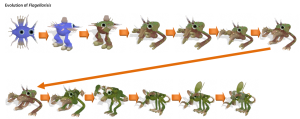Today was my last Year 10 Science lesson. We have been learning about evolution for the last four weeks. Over the four weeks, my class worked in groups to play the game, Spore, while learning about the scientific perspectives of evolution. The aim was to allow them to play Spore and evaluate the scientific accuracy of the game (for more information, see my previous post). Due to the time pressures of the looming high-stakes exam known as the School Certificate, the class only played the cell phase, with some groups playing the start of the creature phase. This still allowed all students to get a fair idea of how the game functioned in terms of evolution. Students also completed simulations that promoted scientific perspectives of evolution so they can critique Spore.
From classroom observations, students enjoyed the game. They asked whether it was their group’s turn to play the game at the start of each lesson and genuinely enjoyed playing the game. While we didn’t have time for the class to create a product to review the scientific accuracy of the game, we had a lengthy discussion on the topic. I displayed the evolution of one group’s spore creature and had the class discuss how the creature had changed overtime and how environmental changes can be inferred from the changes in the creature. This was similar to how environmental changes can be inferred from the fossil record.
We then compared the similarities and differences of evolution according to scientific perspectives and evolution in Spore. We compared the game’s version and the scientific version of how life originated, how changes came about in organisms and whether organisms evolved to “suit” the environment. The last two points were the most important as Spore purports two common misconceptions of evolution – (1) That changes in a species were for a purpose and (2) That organisms grew to adapt to their environment. In contrast evolution from a scientific perspective is random. There is no purpose to evolution and organisms do not evolve to become suited to their environment. Instead characteristics that might be useful to a changed environment come about randomly through mutations and the organisms with these mutations are just lucky that they end up being useful when the environment changes. The two misconceptions that Spore purports are more aligned with intelligent design.
After the discussion, students were asked to post their understanding of the scientific version of evolution onto Edmodo. From their posts, they appear to grasp most of the aspects of evolution:
“Natural selection is the mechanism of evolution. Natural selection involves a group of organisms with favourable charactistics to be able to survive in an environment better than those who do not have these characteristics. This is called adaptation. The organisms that are able to adapt to the environment will successfully pass on their gene and over time many organisms within that group will inherit the same gene.”
“Natural selection is the mechanism of evolution where organisms with a certain characteristic are more likely to survive in the environment. The organisms with this characteristic survive while the other organisms without the characteristic die out. The organisms that survived will pass on this characteristic to their offspring and over time, more and more of those organisms will have that adaptation.”
However, what was more interesting was the students’ apparent perceptions of using Spore in class. From the class discussion it was clear that there were two groups of students. One group treated the game as a serious learning resource and were analysing the game for its scientific accuracy of evolution. The other group dismissed the game as a learning resource and thought using a game as a stimulus for learning about evolution was a joke. This group of students held a very traditional view of what school learning is. They were also the same students who thought 1:1 laptops did not enhance their learning because they thought they learnt better from copying notes (see previous post for more info).
Just like there is research to say that the successful use of technology in education is largely due to a teacher’s perception of learning and teaching, I think the same applies to some extent to our students. Some of our students hold very traditional views of learning and teaching. They believe that they learn by the teacher telling them what to know and what to do. Copying notes from the board, answering comprehension questions and memorising facts allow them to be very successful at the current schooling system. Just like some teachers, these students are comfortable with traditional, transmissive modes of learning and exams tell them they are good at it. I’m not the first person who have thought of this. In my prac teaching back in 2006, my supervising teacher took over a class from a teacher who who taught by the transmission model. My supervising teacher had a very constructivist approach to her teaching and had her students work things out for themselves through a series of self-discovery activities that ran every week. She said she experienced a lot of student cynicism at the start, where groups of students told her that this wasn’t how they learnt.
It will be interesting to find out how students’ perceptions of learning and teaching affect their learning in a classroom that is structured in non-traditional ways. I’m planning to do an evaluation of using Spore and other games in learning activities when the class completes the School Certificate exams to see whether there is a correlation between students’ perception of what learning looks like at school and their attitudes towards games based learning. Suggestions of survey questions or focus group questions are welcome


Pingback: Games and Learning with Little Space Heroes